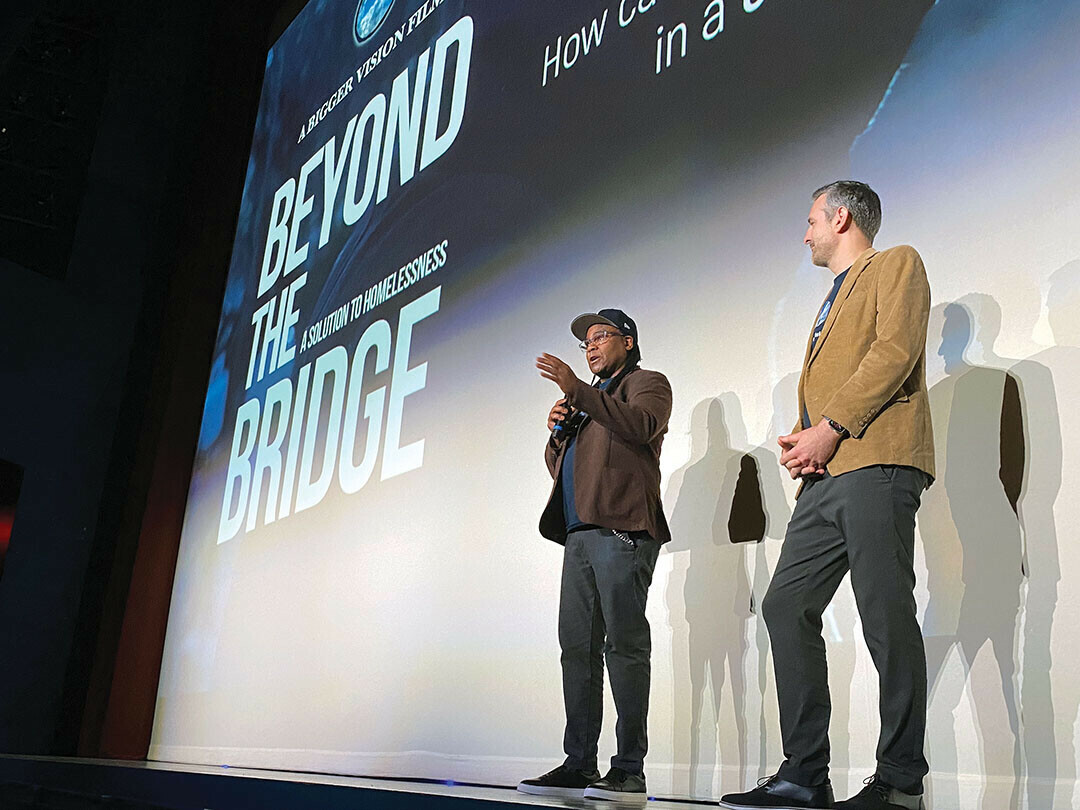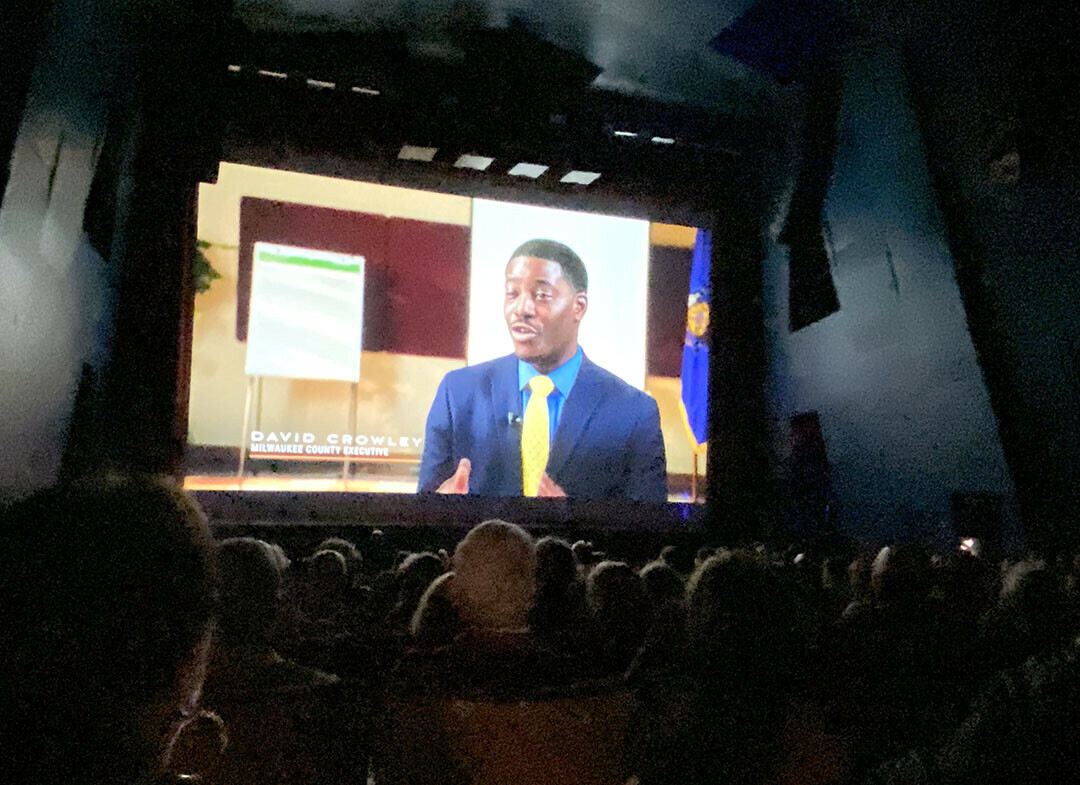Call to Action: ‘Beyond the Bridge’ Film Screening Prompts Discussion on Addressing Homelessness
film highlights collaboration as key to addressing housing crisis
words & photos by Julian Emerson |

After driving more than 40,000 miles across the United States for a year in search of ways to better address the complicated issue of homelessness, Don Sawyer and Tim Hashko discovered a surprisingly simple answer: Agencies must work collaboratively to reduce the number of unhoused people.
“It sounds like it couldn’t be that simple, but it turns out it really is,” said Hashko, cinematographer and editor at A Bigger Vision Films. Sawyer is producer and director at the film company.
How the Indianapolis, Indiana-based filmmakers reached that conclusion plays out in their film, Beyond the Bridge: A Solution to Homelessness, which was screened on Tuesday, Sept. 17, at the Pablo Center at the Confluence in Eau Claire, one of 30 showings nationally. During their cross-country trek making the film, Sawyer and Hashko talked to experts of all sorts and spent time with unhoused people as they sought a solution to a growing housing crisis gripping this nation.
In city after city, they heard about initiatives and innovative approaches to address homelessness. The more they learned about the topic, the more the duo came to believe that one coordinated system around the approach known as Housing First – in which nonprofits and local governments work together closely to address the needs of unhoused people – is the answer.
Hashko and Sawyer said most communities they visited lacked a cohesive, focused approach to addressing homelessness. And from what they can tell, the duo said, that is what they see happening in Eau Claire.
By working collaboratively around a fully serviced Housing First model, agencies and officials in Milwaukee and Houston have found success housing a significant number of unhoused residents, they said.
“The real solution is system coordination,” Sawyer said. “It’s about getting people into housing and providing them with the services so they can stay housed. And doing that works best when the agencies that are providing those services are working closely together.”
Attaining that goal sounds deceptively simple. But Hashko and Sawyer said most communities they visited lacked a cohesive, focused approach to addressing homelessness. And from what they can tell, the duo said, that is what they see happening in Eau Claire.

‘We need each other’
Agencies that work with unhoused people in the Chippewa Valley – many of which were represented during a post-screening panel discussion – acknowledge that homelessness has become increasingly visible in recent years and is stressing available services. That stark reality is forcing a reconsideration of current plans to address homelessness, they said, and prompting discussions about the need to work together more effectively.
David Carlson is the founder of C.C. We Adapt, which provides housing, services, and peer mentoring to unhoused people in 28 Wisconsin counties, including Eau Claire County. Last fall he leased a downtown building to shelter unhoused people, provide them with services, and link them to housing.
“I really jumped all in,” he said. “We did everything we could to help people and find housing for them, yet since then the homelessness numbers have gone up. I have to admit … the bottom line is, despite what we are doing, more people are homeless now. It has taught me that none of us knows everything in this space. We need each other.”
When asked whether entities working to address homelessness in Eau Claire operate too often in their own silos instead of collaboratively, most agency leaders and local government officials questioned said yes. Some cited strong egos and longtime personality conflicts for the impasse.
“We need to get away from the silos,” said TJ Atkins, executive director of The Community Table, which provides meals to people in need. “They aren’t working, and community members are suffering, and resources are not being maximized. It is long overdue in Eau Claire for collaborations to happen. We are at a tipping point now, and if we don’t do something different, things are going to get worse.”
”
It is long overdue in
eau claire for collaborations to happen.
We are at a tipping point now, and if we don't do something different, things are going to get worse.
TJ ATKINS
EXECUTIVE DIRECTOR OF THE COMMUNITY TABLE
‘Make it happen’
This isn’t the first time that agencies providing services to unhoused residents have been told they don’t play well together. In 2019 national homelessness consultant Erin Healy advised agency leaders they need to collaborate more effectively to better serve their clients.
So how do those agencies, local government officials, and others actually come together? Susan Wolfgram, a JONAH member who chairs numerous committees that work to address homelessness, referenced the success of the effort Healy oversaw in the Chippewa Valley that housed 13 chronically unhoused people in 100 days as evidence it can happen again.
“We have committed community partners that can sustain an effort over time as well as elected officials who can ignite the process,” she said. “What we need is the will, for city/county officials as well as our community stakeholders to come from the lens of ‘How can we do this?’ not ‘Why we cannot do this.’ ”
Others said past rifts among organizations and people must be mended and trust must be built before creating a cohesive plan to work on homelessness. Is that possible?
“Maybe,” said Billie Hufford, project management coordinator for the City of Eau Claire. “That depends on individuals.”
Anna Cardarella, executive director of Western Dairyland Economic Opportunity Council, acknowledged differences among agencies but said she believes collaboration can occur. Combining the different approaches of various agencies could be a strength in more fully addressing homelessness, she said.
“I hope it’s possible,” she said. “The idea is to permanently house people. All of us agree that is the end goal. Recognition of that can pull us together.”
Despite challenges, Sawyer and Hashko said they believe Eau Claire is in a good position to find similar success. The fact more than 500 people attended the film screening was a sign the community cares about the topic.
Hufford said a neutral third party is necessary to lead discussions among different players. Astri Gracehart, program director of Home for Good, a housing nonprofit serving Eau Claire, agrees. In fact, she said, furthering such discussions are why she and Carlson worked to bring Beyond the Bridge to Eau Claire in collaboration with C.C. We Adapt, Home for Good, the UW-Eau Claire Center for Racial and Restorative Justice, the Eau Claire Community Foundation, the Pablo Foundation, and the Pablo Center at the Confluence.
“The real message (of the film) is we need to work together,” Gracehart said. “The success we will have on this front won’t be so much about the exact model we use, but about whether we are able to work together in deep coordination and collaboration.”
Despite challenges, Sawyer and Hashko said they believe Eau Claire is in a good position to find similar success. The fact more than 500 people attended the film screening was a sign the community cares about the topic.
“You have a lot of smart people here, a lot of dedicated people,” Sawyer said at a gathering after the film showing. “There seems to be a real commitment here to helping address this issue. Now you all just need to come together to make it happen.”
Learn more about the Beyond the Bridge film online.


















